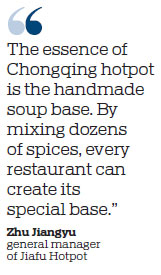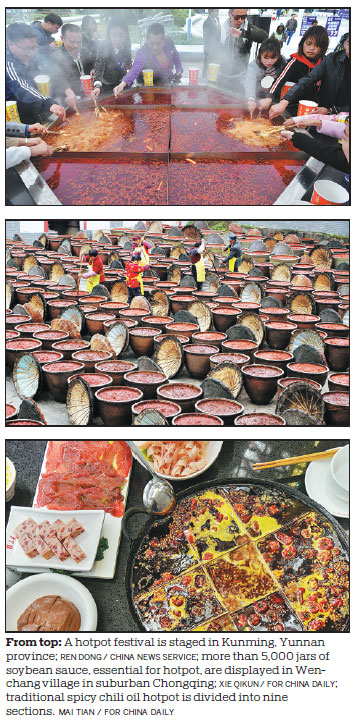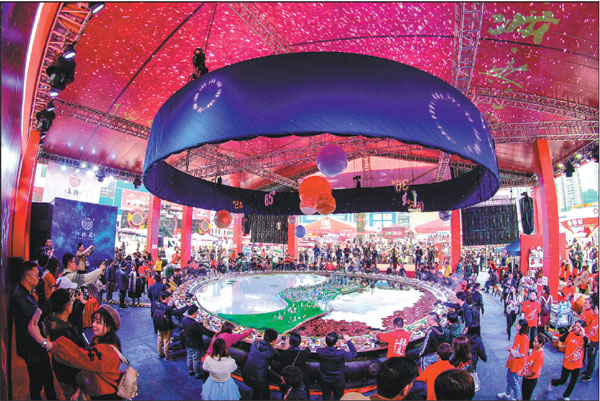WORLDWIDE APPETITE FOR CHONGQING HOTPOT
Tan Yingzi in Chongqing
Updated:2019-03-11
China Daily
Local authorities keep close eye on spicy cuisine's development
In the recent Chinese science fiction blockbuster The Wandering Earth, astronaut Liu Peiqiang tells Russian cosmonaut Makarov that he will invite him to have hotpot in Chongqing after they return to Earth. But Makarov dies before he can make the trip to China.
Although the death scene in the movie is upsetting, fans of this strongly flavored and oily local dish are delighted to see that their favorite food has become well-known - even in space.

Chongqing hotpot has become hugely popular in recent years, especially since the release of the food documentary series A Bite of China II five years ago.
It seems as though there are Chongqing hotpot restaurants in every Chinese city, even though most people in northern and coastal regions have not been big consumers of chili peppers in the past.
Many people believe the cuisine not only reflects the character of Chongqing's people but has also become a driving force of the local economy.
Hotpot cooking is believed to have spread through northern China during the Tang Dynasty (618-907). By the time of the Qing Dynasty (1644-1911), it was popular nationwide.
Although there are many regional variations, the one from Chongqing differs from other styles with its numbing, spicy soup base and special meats and sauces.
All hotpot cuisine is basically the same. While the soup simmers over a flame, meat and vegetables are placed into the pot to cook, and diners can select the items when they are ready to eat.
But Chongqing hotpot has the strongest flavor, with beef tallow, large quantities of chili and Sichuan pepper. The three must-have varieties are ox stomach, duck intestine and large pig or ox artery.
Although there is no evidence of how the cuisine originated, many believe that hotpot emerged from porters' food in the late 19th century.
Chongqing is a port city on the Yangtze and Jialing rivers. In the late 19th century, animals from neighboring Sichuan, Guizhou and Yunnan provinces were shipped to the city by water.
Good meat was brought in and sold to the upper and middle classes. The internal organs, including the stomach and kidneys, were discarded or sold cheaply. Porters picked up or bought the organs and cooked them in a boiling pot with a spicy sauce and ate the food by the rivers.
According to Feng Tu Shi Zhi, a folklore magazine published in the 1940s, the first hotpot restaurant in the city was Ma Zheng Xing, owned by the Ma brothers.
Legend has it that the two brothers tasted the street food and were hooked. They saw a business opportunity and introduced hotpot in their restaurants in the 1930s.
In 1937, the Kuomintang government led by Chiang Kai-shek established Chongqing as the country's capital. The southwestern city went on to play a critical role in the Asian theater of World War II.
At the time, the city witnessed a sudden influx of government officials, bankers, businessmen, scholars, diplomats, writers and other professionals from other parts of the country.
Hotpot soon gained popularity among people from all around the world, with many of the newcomers to Chongqing loving the cuisine. Although they left the city after the war, they took their love of hotpot with them, and the cuisine's popularity spread.
Thriving business
Boasting both the best and largest number of hotpot restaurants in the country, Chongqing was named "China's hotpot city" by the China Cuisine Association in 2007.
According to the Chongqing Hotpot Association, there are more than 50,000 such restaurants in the city, employing at least 3.5 million people. The entire industry is estimated to be worth hundreds of billions of yuan.
The traditional spicy chili oil hotpot is divided into nine sections because in the past, several people shared one pot and put food in their own sections.
To meet the demands of those who cannot eat such spicy food, Chongqing hotpot restaurant owners have developed three soup bases: spicy chili oil broth, a clear broth (usually chicken soup) and a broth that is a mix of the two.
Local people say the development of Chongqing hotpot is linked closely with women from the city who own most of the well-known restaurants. The best-known is He Yongzhi, owner of the Little Swan chain.
The 65-year-old is director of the Chongqing Hotpot Association, and is often known as "the queen of Chongqing hotpot".
In 1982, she opened a small restaurant with only three tables. Now, there are more than 300 Little Swan eateries in China and overseas.
"Chongqing hotpot is just like the city's women - spicy, smart and open-minded," He said.

In 1984, she devised the split hotpot - half spicy, half mild - in order to please all types of diner.
Inspired by two colors - green and yellow - in the waters of the Yangtze and Jialing at their confluence near Chaotianmen pier - she had the idea of creating a double-flavored hotpot.
He's innovation soon spread to all the local hotpot restaurants, attracting an increasing number of visitors from other areas.
As the leader of the local hotpot industry, He plays an important role in establishing the Chongqing cuisine through an annual festival. In 2007, the city set a Guinness World Record when more than 100,000 people simultaneously ate hotpot during the festival.
"I have a bold idea to host a big hotpot party on the Great Wall," He said.
Other large hotpot chains joined with He to promote the cuisine overseas, such as Pei Jie, Qin Ma and Liuyishou, with the latter even setting up an international branch, with the aim of opening 100 outlets worldwide.
There are more than 200 Chongqing hotpot restaurants overseas, including those in the United States, the United Kingdom, Russia, Singapore, Spain and the United Arab Emirates, according to the association, and there is strong growth momentum.
The Chongqing government also pays great attention to the cuisine's development.
In 2012, it announced a plan to build Chongqing into a "food capital" on the upper reaches of the Yangtze, featuring hotpot and other local specialties.
Under this plan to build the city into a well-known international travel destination, Chongqing hotpot will become a local cultural brand.
Challenges ahead
Like many other local cuisines, Chongqing hotpot lacks a professional branding system, standard production process management and a general development plan.
As a result, the Chongqing Hotpot Academy was launched in 2014 by the hotpot association, the Chongqing Cuisine Association and the Chongqing Modern Vocational Training Academy.
Li Dejian, president of Dezhuang Hotpot, said, "Despite there being several million hotpot workers in the city, there is still a shortage of professionals."
The academy has created a teaching and practice system, Li said, adding that creativity and innovation are also important.
Zhu Jiangyu, general manager of Jiafu Hotpot, said, "The essence of Chongqing hotpot is the handmade soup base. By mixing dozens of spices, every restaurant can create its special base."
Since 2014, Chongqing has been applying to add hotpot to the Statelevel Intangible Cultural Heritage List in order to protect the traditional cooking process, skills, utensils and dining style.
tanyingzi@chinadaily.com.cn
|
Diners eat from a huge hotpot at a festival in Chongqing. The four-day event attracted thousands of diners and enterprises.Liu Chan / Xinhua |

(China Daily 03/11/2019 page1)
Video

John Edwards, the UK trade commissioner for China, praised Chongqing over its rise as a burgeoning center in intelligent manufacturing.






